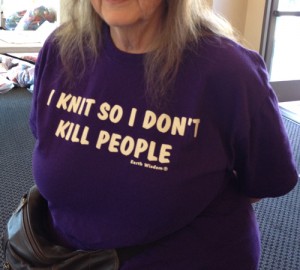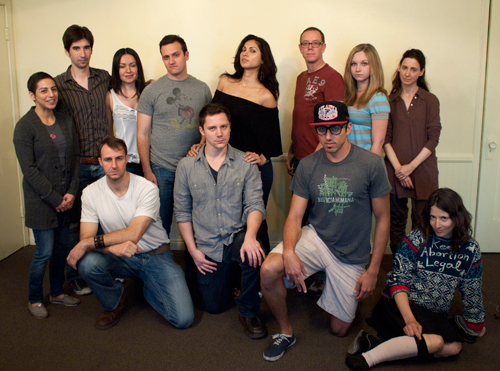Sometimes you have to pack it all in. A weekend last month taught me a perfect triad of new skills. On Saturday I began the day with a crew of spinners. In the afternoon, I went to acting class, then home for a mellow walk to a neighborhood bar and video store. An early bedtime prepared me for a Sunday morning of tactical handgun training in the mountains. The weekend ended with gourmet ice cream. Los Angeles is a magical world.
The weather was beautiful all weekend. Sunroof open, I drove to a West Side church where the Greater Los Angeles Spinning Guild was having their monthly meeting. These aren’t the kind of spinners riding stationary bikes. These are primarily ladies, and they’re equipped with spindles and wheels and loads of natural fibers that they draw into long, even strands for weaving and knitting. The technology is old and new. Wheels are made of plywood or hardwood. Some are plastic. Spinning wheels can be small and mighty, large and rangy, or somewhere in between. Members sit on folding chairs and spin. I am attracted to spinning as a witchy past-time; I like the idea of spinning the future. I am a new member of the Guild.
The program was about spindles. Guild members stood up to talk about various types. Some are supported, by spinning on the floor or on a table, and others drop down as the yarn is formed by the spin. Anita showed examples of suspended spindles, top whorl and bottom whorl. Andrea demonstrated how a Turkish spindle allows the newly spun yarn to be wrapped around the spokes. Support spindles spin like tops, sometimes in a small bowl. A Navajo spindle is large and spins on the floor. Sheila took off her shoes to operate her kick spindle. At the end of the demonstration, she said it was for sale. It was sold almost immediately.
A table at the front of the meeting was filled with spindles and during the raffle-drawing, everyone came up to take a close-up peek. A peppy spinner blinged out her custom spindle with swarovski crystals. A spindle made by a scientist and knife maker in Pasadena had a heavy bronze wheel that gave it a wonderful weight. Probably too heavy for me, I’m not a great spinner. Or even very good. I didn’t win anything at the raffle. Was hoping for some chocolate colored alpaca. Better luck next time.
At the end of the meeting, we made our own spindles. It’s a simple process, especially when someone else buys all the parts and gets them ready for you. Dowels fit into wooden toy wheels. We sharpened the dowels with a pencil sharpener. The wheel is held on with small rubber bands sold for livestock castration. A hook screws into the end of the dowel. Two minutes later, the spindle is a new tool.
A blond lady with glasses wore a sequinned purple baseball cap and a matching purple shirt that read, “I knit so I don’t kill people.” I’m not confident that the two are mutually exclusive.
The first rule of improv is “Yes, and…”
The idea is that one should always affirm whatever has been previously said. You can’t argue with facts, even if the facts are absolutely ridiculous. Go with it, whatever it is. This keeps scenes rolling and prevents division between scene partners. In improv, thinking ahead is all but impossible. There might be a burning hilarious idea that needs to come out somehow, but if it can’t fit with the scene, it’s dead. Just bringing something up out of the blue makes everyone look stupid. In class, we are encouraged to speak without thinking. It’s terrifying to think what might come out of my mouth.
The aims of the members of the class vary. There are 16 of us. A couple are lawyers, looking to improve their public speaking and hoping to acquire skills for “thinking on their feet.” There are a handful of comedy writers, and more than a few actors. I’m here to start myself thinking about performance. It’s challenging. And fun!
The first rule of tactical handgun training is “don’t point a loaded handgun at a human.” Seems pretty straightforward, but by the early afternoon, just as the sun was squirming downward in the winter sky, we were “clearing houses” and safety didn’t seem quite as important as making sure that all the bad guy targets were shot in the heart or ocular cavity. If you’re really needing to kill someone quickly, shoot them in the eyes. It’s the only guarantee that they’ll go down. A heart shot is great, but they might have 15 seconds, and that’s an eternity in gun time.
I ended up at tactical handgun training because I was invited. Invitations to tactical handgun training don’t come very often. A new buddy is a gun nut. She doesn’t own just one gun. A few weeks earlier, we’d gone hiking and then stopped at Walmart for ammo. She bought everything they had in stock. Another night, after an evening of tequila and wild boar, she invited me and a friend to come shooting. Who can say no?
We drive a long and winding mountain road to the shooting range and then pass by the signs that say “Do Not Enter,” which seems like something you definitely don’t want to be doing at the gun range but that’s what our instruction sheet said so we did it. There are a lot of ranges out there, and people are shooting all sorts of weapons. “Discharging” is the term they use. Not “shoot.” I guess “shoot” sounds too violent.
We check out our guns from a very nice group of young people all clad in black. We are issued Glocks. Glocks don’t have a traditional safety, and this totally freaks me out. But I deal with it, and I push the 9mm bullets into the cartridge and line up with everyone to listen to a very intense speech by a very intense guy named Bill who tells us how many gang members there are in Los Angeles and that gun ownership is the best way to ensure that they don’t kill us.
We line up to start shooting. We are taught a three-movement series to bring the gun from the holster to shooting position using both hands. We start shooting. I am so close to the stranger standing next to me that we almost touch. There are about 25 of us and we are all shooting handguns at the same time. I learn that the safety function of the Glock is that it’s just a tougher trigger to pull than a handgun that has a safety. This doesn’t make me feel much better. There are bullets flying everywhere, but the group is aiming carefully and no one catches any strays. No one else really seems worried about the possibility of a hit. When we later go into the “houses” and people are shooting willy-nilly because we are really and truly imagining PCP smoking gangsters at every turn, the bullets land in walls that have been filled with gravel. The bullet can’t go through. Ricocheting is a different issue that we try not to think about. Bill tells us that there are 3 reasons to shoot a gun. Country, love, money. His motto: Overkill never fails.








